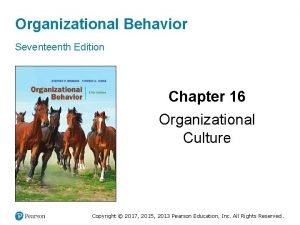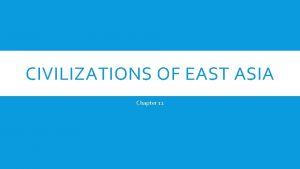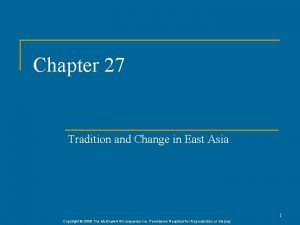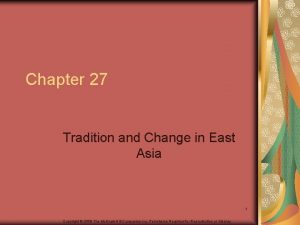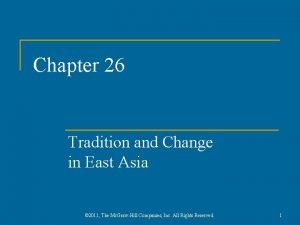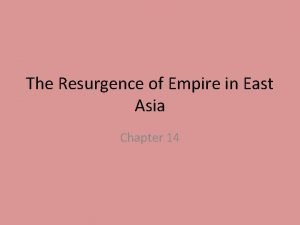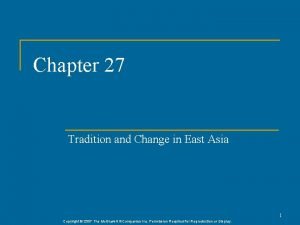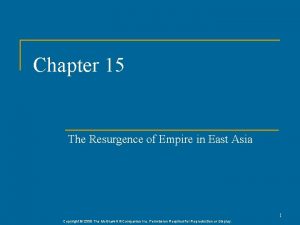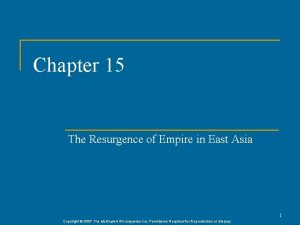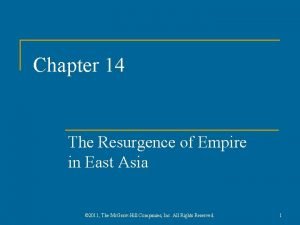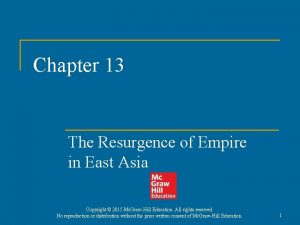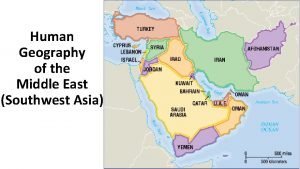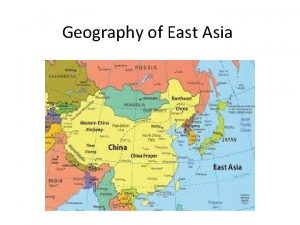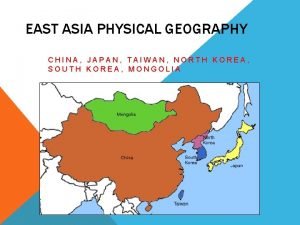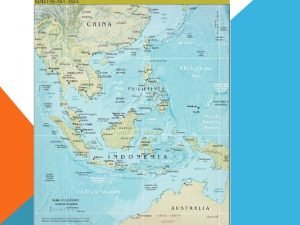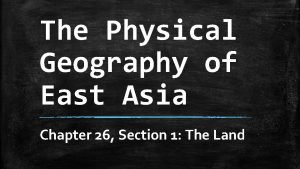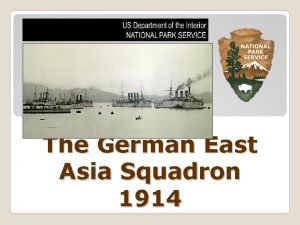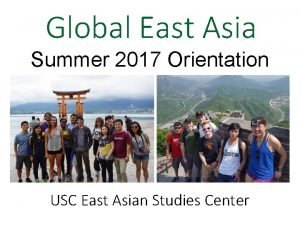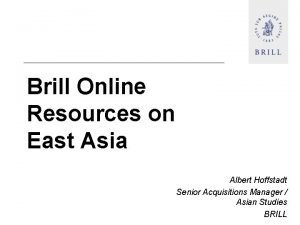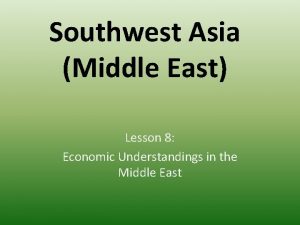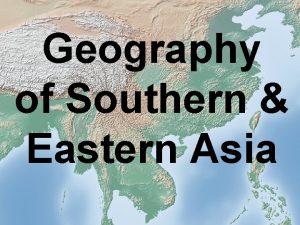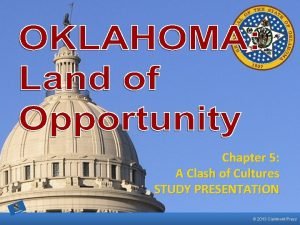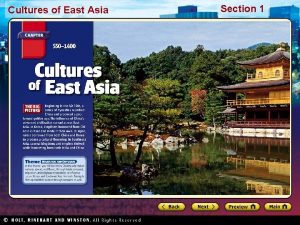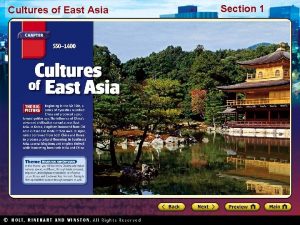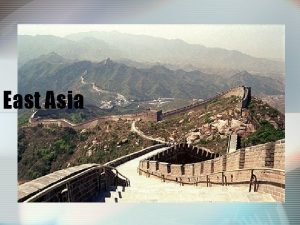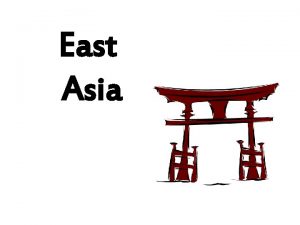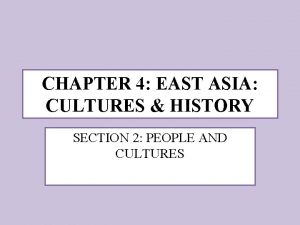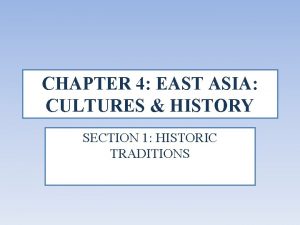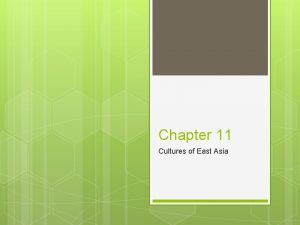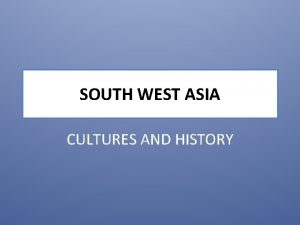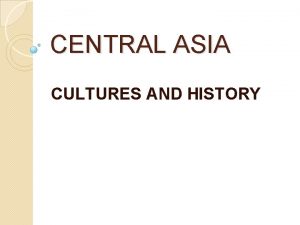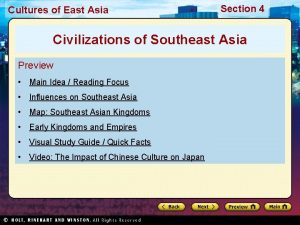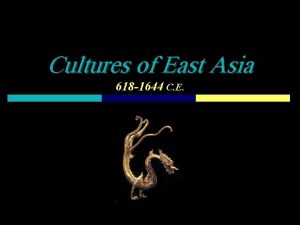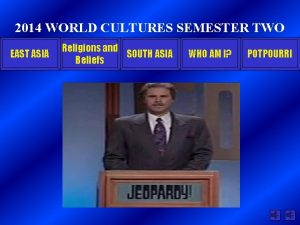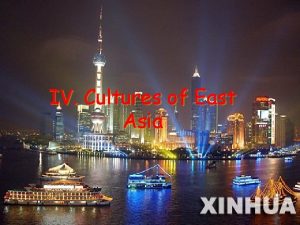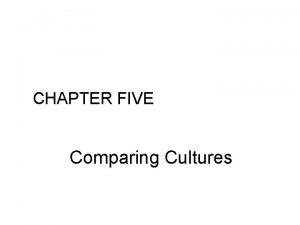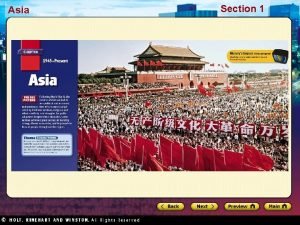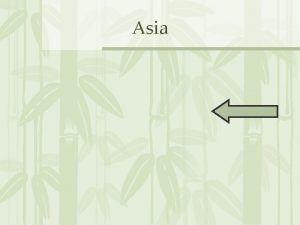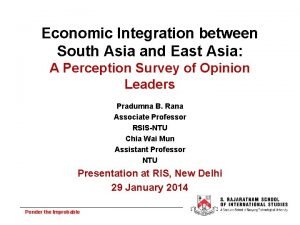Chapter 11 Cultures of East Asia Sections 1






























- Slides: 30

Chapter 11: Cultures of East Asia

Sections 1: Chinese Empires Main Idea The Sui dynasty reunified China, after which the Tang and Song dynasties produced an age of prosperity and achievement. Objectives • How did the Sui and Tang dynasties reunify China? • How did the Song dynasty strengthen China? • What were some Tang and Song cultural achievements? • How was this period a time of prosperity and social change?

Early Dynasties ØZhou, 1050 -256 BC: Mandate of Heaven ØQin (Ch’in) Dynasty, 221 -206 BC: “China, ” started Great Wall ØHan, 206 BC-AD 220: civil service system, Silk Road


Great Wall of China (Qin Empire)

Terracotta army of Shih Huang-ti (Qin Empire)

the “Silk Road” (Han Dynasty)

I. The Sui and Tang Dynasties AD 220 - Han dynasty collapsed, China split into rival kingdoms - the “Period of Disunion”

I. The Sui and Tang Dynasties AD 589 - northern ruler Wendi reunified China and founded the Sui dynasty Emperor Wen of Sui Dynasty (541 – 604), personal name Yang Jian

I. The Sui and Tang Dynasties Wendi’s son Yangdi finished the Grand Canal, linking northern and southern China The Grand Canal is still an important waterway today

I. The Sui and Tang Dynasties Yangdi forced millions of peasants to work on the canal; thousands died, led to rebellion

I. The Sui and Tang Dynasties 618 – Yangdi assassinated; Sui dynasty ended, Tang began Yang Di - Emperor Yang of Sui (569 - 618), personal name Yang Guang, alternative name Ying, nickname Amo, also known as Emperor Ming

I. The Sui and Tang Dynasties Tang extended west, made contact with India; influenced Korea and Japan

I. The Sui and Tang Dynasties Most expansion occurred under Taizong; also built schools to train students for civil service Emperor Taizong of Tang, ruled China from 626 to 649. Considered one of the greatest rulers in Chinese history, his accomplishments, both economic and military, were required study for subsequent emperors. Under his reign, China included modern Viet Nam, Mongolia, and central Asia to Kazakhstan. He ruled as Tian Kehan, which translates as 'Heavenly Khan".

I. The Sui and Tang Dynasties Taizong’s son was weak - wife Wu Zhao gained power; only female emperor in Chinese history Empress Wu Zhao 625 - 705

I. The Sui and Tang Dynasties c. 400 – 845: Age of Buddhism. Appealed to people because it promised peace and escape from suffering

II. The Song Dynasty 907 - Tang dynasty ended, China divided 960 - Song dynasty established

II. The Song Dynasty Neo-Confucianism popular - emphasized Confucian ethics, spiritual matters

II. The Song Dynasty Civil service exams difficult but a pathway to wealth and status; the successful formed a new social class – the gentry Confucian scholars take a civil service examination (reenactment)

III. Cultural Achievements The Tang produced great poets Li Bo and Du Fu, and artists like Wu Daozi Li Bo Du Fu

III. Cultural Achievements The Tang made pottery figurines; the Song excelled at porcelain Red Pottery Figures of Earth Spirits from the Tang Dynasty Blue-white porcelain, Northern Song Dynasty (960 -1127)

Rare 900 -year-old Song Dynasty porcelain bowl, the Ruyao Washer. Believed to be the only one of its type in the world, it sold for $26. 7 Million at a Sotheby's auction in April 2012.

III. Cultural Achievements Inventions and innovations: pagoda magnetic compass

III. Cultural Achievements Inventions and innovations: gunpowder woodblock printing moveable type paper money

IV. Prosperity and Society Agriculture became more productive because of new irrigation methods & a new type of rice

IV. Prosperity and Society Merchants became more important in society as trade grew; most people remained peasants Foreign trade caravan Chang'an market scene

IV. Prosperity and Society Sea trade increased when overland trade routes were lost Tang Dynasty Ship

IV. Prosperity and Society Women's status declined, foot binding spread – a symbol of a husband’s wealth and authority over his wife


Emperor Ming, aka Ming the Merciless, from the planet Mongo - archenemy of the heroic Flash Gordon and of all mankind
 Organizational cultures often reflect national cultures
Organizational cultures often reflect national cultures Guided reading activity civilizations of east asia
Guided reading activity civilizations of east asia Chapter 27 physical geography of east asia
Chapter 27 physical geography of east asia Chapter 27 tradition and change in east asia
Chapter 27 tradition and change in east asia Chapter 27 tradition and change in east asia
Chapter 27 tradition and change in east asia Chapter 26 tradition and change in east asia
Chapter 26 tradition and change in east asia Chapter 14 the resurgence of empire in east asia
Chapter 14 the resurgence of empire in east asia Chapter 27 tradition and change in east asia
Chapter 27 tradition and change in east asia Chapter 15 the resurgence of empire in east asia
Chapter 15 the resurgence of empire in east asia Chapter 15 the resurgence of empire in east asia
Chapter 15 the resurgence of empire in east asia Chapter 14 the resurgence of empire in east asia
Chapter 14 the resurgence of empire in east asia The resurgence of empire in east asia
The resurgence of empire in east asia Human geography of middle east
Human geography of middle east Oceania in 1984
Oceania in 1984 Geography of asia
Geography of asia Taiwan physical geography
Taiwan physical geography Climate regions in east asia
Climate regions in east asia Physical geography of east asia
Physical geography of east asia The commander of the german east asia squadron was
The commander of the german east asia squadron was Chartch
Chartch East asia & sushi
East asia & sushi Usc summer orientation
Usc summer orientation East asia
East asia Lesson 8 middle east and south asia
Lesson 8 middle east and south asia East asia physical map
East asia physical map Post classical vietnam
Post classical vietnam Winds that blow over short distances are called
Winds that blow over short distances are called Laissez faire theory
Laissez faire theory East is east and west is west
East is east and west is west Chapter 20:11 using reagent strips to test urine
Chapter 20:11 using reagent strips to test urine Chapter 5 a clash of cultures
Chapter 5 a clash of cultures
